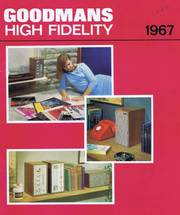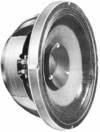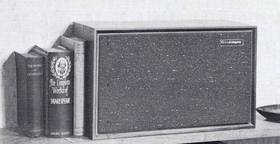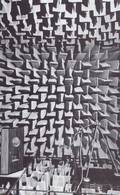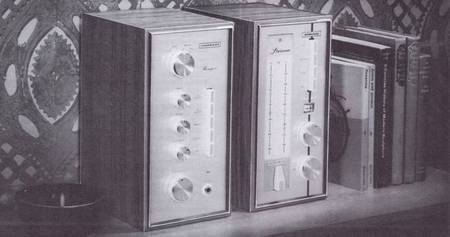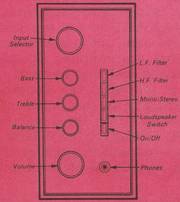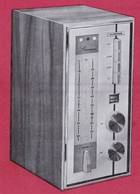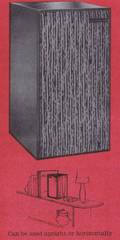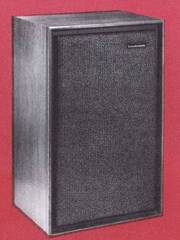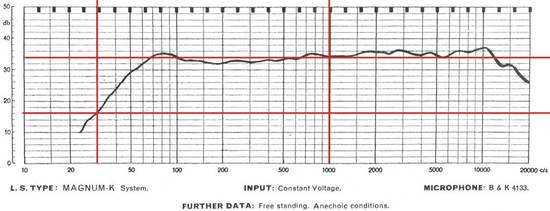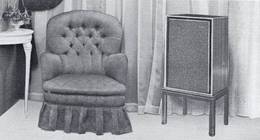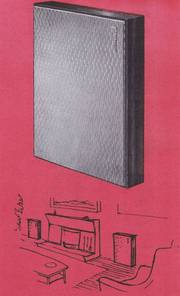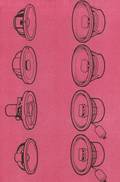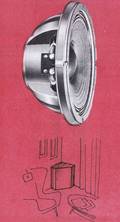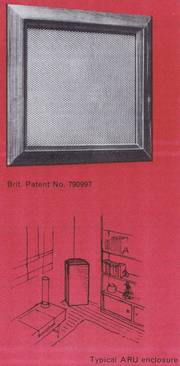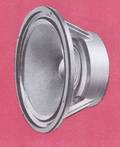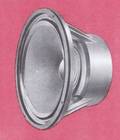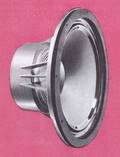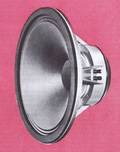Ein weiterer Goodmans Gesamtprospekt von 1967
In 1967 kam eine deutliche Bewegung in die (Frankfurter) Hifi-Szene. Zwei Rundfunk- und Hifi-Verkäufer aus dem großen Bieberhaus (einem damals enorm großen Elektrokaufhaus ganz hinten auf der Zeil) kündigten zum Jahresende und machten sich mit einem ganz kleinen Hifi-Laden in der Sandhofpassage - etwas abseits hinter der Zeil - selbständig.
Ihren anfänglich kleinen Edel-Hifi- Laden nannten Sie "Raum-Ton-Kunst". Es sollte mit das renommierteste Hifi-Studio im ganzen Frankfurter Raum werden. Herr Nowak und Herr Bruns setzten hier mit enorm viel persönlichem Engagement neue Maßstäbe.
Auch bei Goodmans in Wembley änderte sich die Richtung - weg von den einzelnen Lautsprecher-Chassis hin zu einer kompletten Boxenfamilie - aber nach englischem Geschmack bitte.
Seit 30 Jahren produzieren sie Lautsprecher-Chassis
So steht es in der Historie, mit der "sie" werben. Und im Prospekt sind doch einige Kavenzmänner im 38cm Bereich zu sehen. Die müssten doch einen gewaltigen Bass machen.
Jedenfalls die großen (und teuren) JBL Bass-Chassis aus diesen Jahren wummerten unten rum bis zum Erdbeben. Und in ihren eigenen Boxen bekommen die Goodmänner das einfach nicht hin ?? Für die große Magnum-K, die so sehr mit Eigenlob überschüttet wird, ist das eine einzige Blamage sondersgleichen.
.
GOODMANS High Fidelity 1967
Goodmans Industries of Wembley, England, are the largest manufacturers of High Fidelity loudspeakers in Europe. This lead has been gained by constant research and development, and by meticulous attention to detail and a very high standard in all phases of design and production.
The extensive loudspeaker range has now been augmented by other components in the High Fidelity chain; notably the MAXAMP 30, the FIRST British all-silicon transistor stereophonic High Fidelity amplifier - and the STEREOMAX - the matching AM/FM stereophonic Tuner. Goodmans are proud of their Tradition of Excellence, both mechanical and acoustical.
Anechoic Test Chamber in Goodmans Laboratories
Pictured here is part of the anechoic chamber in the laboratory wing. The function of this room is to simulate free-space conditions. Absolute acoustic measurements can be made to such a degree of accuracy that results obtained can be used not only for research and development, but also as a basis for discussion with national and commercial laboratories throughout the world.
The room occupies 4,500 cubic feet, and all its internal surfaces (including the power-operated slide-away door) are lined with bonded glass-fibre 'wedges' 3 feet long. To minimise structurally borne vibrations within the room, the whole chamber, complete with its masonry, is resiliently suspended within the main building.
Our program
In these pages you will find the most complete and advanced range of High Fidelity loudspeakers in the world. And now, of course, Goodmans transistorised Stereo Amplifier - MAXAMP 30 (pages 5-7 and the AM/FM Stereo Tuner - STEREOMAX (pages 8-9) designed to match in performance and style.
Be guided by the comments on each page, relating them to your own personal requirements. In case of difficulty do not hesitate to use Goodmans free advisory service - by telephone or letter - which is equipped to advise you in all matters relating to sound reproduction.
.
A guide for beginners in High Fidelity
A special guide for beginners in High Fidelity is on page 4, and an article on the "Mysteries" of Stereo - on page 26.
Next to each Loudspeaker you will find details of the recommended enclosure for that loudspeaker. These drawings are sufficiently detailed for any cabinet maker. On the Price List will be found a list of manufacturers who have submitted samples of their enclosures to Goodmans Acoustic Laboratory and who have received Goodmans' Laboratory Approval for the cabinets listed. Some of the firms listed will make these cabinets to your individual choice of colour and grille-cloth.
On the right is a cross-section of the most popular 12" twin-cone single unit High Fidelity loudspeaker in the world - the AXIOM 301. 12" diameter - 20 watts power - 15 ohms impedance. (For more details and recommended cabinet details see pages 18 and 19.)
.
CONTENTS
| Page | |
| Opposite............... | 2 |
| This page.......... | 3 |
| Introduction to High Fidelity... | 4 |
| Maxamp 30........ | 5,6,7 |
| Stereomax.......... | 8,9 |
| Maxim.......... | 10 |
| Mezzo II.......... | 11 |
| Magnum-K......... | 12 |
| Eleganzia II........ | 13 |
| Axiette 8............ | 14 |
| TwinAxiette 8.......... | 15 |
| Axiom 80.......... | 16 |
| Axiom 10.......... | 17 |
| Axioms 201 and 301....... | 18 |
| Triaxioms 212c and 1220c | 19 |
| Components.......... | 20 |
| Stagebuilding......... | 21 |
| Acoustical Resistance Units (A.R.U.) | 23 |
| Audiom 81.......... | 24 |
| Audiom 91.......... | 25 |
| High Fidelity Stereophonic Sound Reproduction | 26 |
| NOTE page............ | 27 |
Contact :
GOODMANS INDUSTRIES • AXIOM WORKS • LANCELOT ROAD • WEMBLEY • MIDDLESEX • ENGLAND
Telephone: WEMbley 1200. Cables: Goodaxiom, Wembley, England. And from Agents and Distributors in most Countries. - A Division of "Radio Rentaset Products Ltd."
BEGINNERS' PAGE- INTRODUCTION TO HIGH FIDELITY
All Radio Receivers, Radiograms, Record Players and Tape Recorders contain an Amplifier and a Loudspeaker. In many cases the quality of the amplifier and loudspeaker is governed by considerations of cost and available space, and although the resulting sound quality is adequate for general entertainment it cannot produce the sense of being actually "there" - at a live performance.
To be "there" you need really faithful sound reproduction - High Fidelity - and this can only be achieved by the use of an amplifier and loudspeaker which have been designed - without compromise - for this very purpose. Naturally, the gramophone pick-up, microphone, tape or radio unit which feed the amplifier must be of the same high order of quality, as also must the signal source itself, whether it be a record, a tape, or an F.M. broadcast.
BUILDING THE SYSTEM
In building up a High Fidelity system you may want to use any or all of these signal sources, but will only need ONE amplifier and loudspeaker system!
Figure 1 shows very simply the main components of a complete installation. The "control unit" is part of the amplifier (often referred to as the pre-amplifier); it contains the controls for volume, treble and bass, etc., and is sometimes physically separate from the main part of the amplifier - though usually sold together - so that it can be installed in a position where the controls are conveniently to hand.
It also contains a selector switch so that you can - by turning the knob to the position shown, connect the gramophone pick-up, tape recorder, radio or other sound source to the amplifier.
All the components shown in the diagram, except the loudspeaker, can be built into the same cabinet, or "built-in" to a room in any way that you wish (e.g. shelves, room dividers, etc.).
The loudspeaker, however, needs its own specially designed enclosure if it is to perform properly. Details of suitable enclosures are given in this manual. The system in Figure 1 is a monophonic system; on page 26 you will find a description of this type of system, also an explanation of stereophonic systems, and their advantages.
HOW MUCH TO SPEND
Whatever installation you decide upon, you will have to choose a loudspeaker to do justice to the rest of the equipment. Your choice will be governed by three main considerations.
.
(1) The amount you are prepared to spend on the loudspeaker system.
(2) The size of the room in which it is to be used.
(3) The possibility of later development of the system.
.
A useful guide to the expenditure on the different parts of a High Fidelity system is to divide the total into three roughly equal parts - so that you spend about the same amount on the loudspeaker and its enclosure, as you spend on the amplifier with pre-amplifier, and about the same amount again on each signal source.
NOW FOR THE LOUDSPEAKER
The size of your room influences your choice of a loudspeaker. A small loudspeaker (e.g. Axiette 8 or Axiom 10, pages 14 and 17) would be large enough for most sitting rooms, and in addition the enclosure is compact.
However, there is no bar to using a larger loudspeaker for even better sound (e.g. Axiom 201 or Axiom 301, page 18), except that the enclosure is rather larger.
There is often a fear in people's minds that a large loudspeaker will be "too loud". This is quite unfounded as the loudness is under your own control at all times. A large loudspeaker is capable of producing a larger volume of sound than a small one, so it may be worth considering if it is likely that your "Hi-Fi" might later be moved into a larger room. A 12" Axiom is ideal as the basis for a stage-built system (page 21.)
The system should be quality balanced
It is very important that a High Fidelity system is "quality balanced". All the components should be ultimately of the same degree of quality: our Technical Advisory Service will be pleased to help you. Incidentally, it is not usually advisable to replace the loudspeaker in a "mass production" radiogram with a High Fidelity loudspeaker, as any imperfections not ordinarily noticeable with a general purpose loudspeaker will be reproduced faithfully - and distressingly - by the High Fidelity loudspeaker.
HIGH FIDELITY TRANSISTORISED STEREO AMPLIFIER AND TUNER - MAXAMP 30 & STEREOMAX
For more than 30 years Goodmans have led the field in High Fidelity Loudspeaker design. NOW another major step has been achieved by the release of the MAXAMP 30 - the FIRST British High Fidelity all-silicon transistor stereophonic Amplifier AND the STBREOMAX-Goodmans AM/FM Stereophonic Timer.
Designed to complement each other in performance and styling the MAXAMP 30 and the STEREO-MAX are fitting partners in todays most compact and sophisticated High Fidelity sound system. Both units are supplied complete in either Teak or Walnut finish polished-wood housings instantly ready for smooth book-shelf installations.
If preferred the housings are easily removable for flush panel mounting in an equipment cabinet. Loudspeakers with any impedance between 4 & 20 ohms may be used with MAXAMP 30. Goodmans MAXIM, MEZZO or MAGMM-K are good examples of reasonably compact loudspeaker systems. For the finest results, all associated equipment should be of the same high order of quality.
STEREO AMPLIFIER MAXAMP 30 - SPECIFICATION
Power Output: 30 Watts r.m.s. maximum (15 Watts per channel) into an 8 ohm load. 20 Watts r.m.s. maximum (10 Watts per channel) into a 4 or 15 ohm load. Total Harmonic Distortion: Less than 0,3% for 15 Watts per channel into an 8 ohm load at 1,000 Hz - Frequency Response: 20 Hz to 20 kHz -0,5db.
Hum & Noise: With reference to 15 Watts, volume control at maximum, all inputs -55 db overall. Main section of amplifier only -80 db with input shorted. Crosstalk:
With input selector in any position, with unused channel input open circuit, better than -40 db with reference to 10 Watts into 8 ohms on the active channel. Supply: Adjustable for 105-120-200-220-240 volts AC 40 - 60 Hz
CONTROLS AND FACILITIES
Input Selector: A clearly marked rotary input selector provides choice of pick-up, radio, tape, or auxiliary, as detailed in the Performance Specification. Volume Control: A ganged control gives simultaneous control of both channels.
Balance Control: A ganged control provides accurate balance facility. At extremes of rotation each channel is silenced. Bass Control: A ganged control enabling boost or cut up to 12db at 50Hz. - Treble Control: A ganged control enabling boost or cut up to 12db at l0kHz.
Low Frequ. Filter: A push-button control inserting a high-pass filter giving a cut of l0db at 20Hz, ultimate rate 12db/octave, for the rejection of turntable rumble signal. H. F. Filter: A push-button control inserting a low-pass filter with an 8 kHz turnover, giving a cut of 16db at 20 kHz ultimate rate 12db/octave, for use with old recordings, limited range signals, interference rejection etc. Mono/Stereo Control: A push-button control combining both output channels for monophonic signals. On/Off: A push-button control, with associated pilot light. Phones Socket: On front panel, for connection of stereophonic headphones.
Loudspeaker Switch: A push-button control for muting the loudspeakers during headphone listening. Power Outlet: A power outlet is provided on the rear panel for feeding turntable, tuner, etc. Controlled by main On/Off switch. Lead and plug supplied.
Fuses: A fuse is fitted in the A.C. power circuit for overall protection, and additional fuses are fitted in each output circuit to protect the output transistors.
HIGH FIDELITY TRANSISTORISED STEREO TONER
STEREOMAX A.M. F.M. - STEREO - Specification
A.M.
Tuning range...... 550 - 1650 kHz (186 - 550 metres)
Intermediate frequency...........470 kHz
F.M.
Tuning range...........87.5 - 108 mHz
Sensitivity....2uV for 20db quietening (I.H.F.M.)
Intermediate Frequency.........10.7 mHz
Discriminator bandwidth......500 kHz peak to peak
Distortion......Less than 1% at 75 kHz deviation
Hum level.............. - 80db
A.F.C............... ±100 kHz
Stereo decoder crosstalk........ - 30db at 1 kHz
Deemphasis...50usecs British (75usees American)
Stereo separation............30db
Power supply..........110, 200 - 250V A.C.
Stereo F.M.-decoder optional
All Silicon transistors - 18 transistors + 18 diodes
Den Rest der Features aufzuzählen lohnt nicht, der Stereo-Decoder kostete sowieso extra, damit war das Teil in 1967 bereits unverkäuflich.
.
COMPLETE HIGH FIDELITY LOUDSPEAKER SYSTEMS
.
MAXIM
This tiny Loudspeaker system is the smallest true High Fidelity reproducer in the world, and represents a major break-through in the battle of Space versus High Fidelity! The Maxim gives full-sized real High Fidelity reproduction BUT in an enclosure so small that even two (for stereo) can be "lost" among books on a shelf or mantelpiece.
It has been described as "shoebox size"; the largest dimension is less than a foot - actual size 10" x 51" x 7" deep. Power handling - 8 watts with an easy competence - ample for any domestic listening. Most important of all - it gives true High Fidelity reproduction - over a frequency range of 45-20,000Hz. The handsome little enclosure is meticulously -finished in triple-coat, hand-rubbed teak or walnut - to order.
- Anmerkung : Das ist natürlich auch lächerlich bis unglaubwürdig, den Frequenzbereich dieser Minibox bis herunter zu 45 Hz zu spezifizieren. Die ganz große Magnum-K Box (weiter unten) ist bis 35 Hz spezifiziert, aber dort hat die Kurve bereits -16dB Abfall, da kommen keine 35 Hz raus, also alles fast schon "Lug und Trug", das bestimmt nicht nach DIN 45500 gemessen.
.
Ein "begeisternder Reproducer"
The development of this amazing reproducer has involved the most exhaustive investigations into diaphragm behaviour and electro-magnetic characteristics. The result is two tiny precision direct radiator drive units, with the most unusual capabilities.
Quite apart from their ability to handle more than enough power for domestic listening, they cover the frequency range with less deviation from level response than almost any other High Fidelity Loudspeaker.
These "mighty midget" drivers were developed exclusively for use in this very tiny enclosure, so that in this sized housing they are giving optimum results. If they were housed in a larger enclosure, performance would suffer.
It has taken a long time for Goodmans' experienced designers to achieve results like this, so give the Maxim the signal it deserves! Treat the Maxim as you would any top quality High Fidelity Loudspeaker; use a High Fidelity Amplifier and Radio Tuner/Transcription Turntable/Tape Recorder.
Do not take liberties with the Maxim because of its size. If you feed distortion to it, it will reproduce the distortion.
MAGNUM-K
The Magnum-K is the most exciting result of Goodmans many years experience in low distortion wide-range loudspeaker systems. Designed to a very high standard for monitoring studios, the Magnum-K brings these same standards to the audio enthusiast at home.
It is a 3-way system, and although reasonably compact (15" x 24" x 11"), no performance compromises have been accepted. Every detail that could contribute to really accurate sound reproduction has been included.
Magnum-K is exceptionally versatile - both middle and high frequency units are adjustable by means of mounted attenuators - and it is able to handle up to 25 watts of power - though due to its high efficiency, amplifiers from 6-12 watts are quite adequate for use in the home.
.
The Bass reproducer is a new 12" unit with a unique moving assembly. Air cushion suspension is employed (first used by Goodmans in the 1930's) in the same manner as in the fabulously successful Maxim Mini System. The result is minimal distortion right down to 20 Hz. The bass unit is built into a new and very strong chassis of open construction.
- Anmerkung : An dieser Stelle kommt die Frequenzgang-Kurve aus dem Magnum-K Prospekt, die zeigt gar deutlich und sogar ehrlich, daß diese Box Frequenzen von 20 Hz gar nicht wiedergeben kann. 60Hz als untere Grenzfrequenz wäre in Ordnung. Hier wird der Leser oder Interessent, der diese Kurven nicht interpretieren kann, vollkommen in die Irre geführt, er wird schlicht belogen bzw. betrogen.
.
Weitere Lobeshymnen
The mid-range unit is a newly developed direct radiator with precisely controlled characteristics, built into a closed die-cast chassis. The high-frequency unit is a precision built back-loaded direct radiator with outstanding smoothness of performance.
A multiple section cross-over network operates at 1,500 Hz and 6,000 Hz.
Variable controls of the constant impedance type are fitted to permit independent control of mid-range and high frequency units to suit individual taste and the acoustical characteristics of the room in which the system is used. The handsomely dignified enclosure finely finished in Teak (or Walnut) is very solidly built, and has rigorous internal treatments to damp out any panel resonances, and provide an air-tight enclosure.
Specification
Dimensions.........15" x 24" x 11" deep (38cm x 61cm x 28.5cm)
Frequency Range..........30-20,000 Hz
Maximum Power Capacity........25 watts
Impedance..............4-8 ohms
Finish.........Teak (or Walnut to order)
ELEGANZIA II
Since its introduction in 1965) the Eleganzia II has proved to be the most sought-after slim-style High Fidelity loudspeaker system. The smoothness of its performance, combined with its fantastically shallow dimension ONLY 6" deep (front to back) make the Eleganzia II an ideal loudspeaker system for even the smallest living room (or even two for Stereo).
The generous power handling capacity caters equally well for large rooms or even public recitals in smaller halls where High Fidelity is demanded. Dignified simplicity in styling is combined with an ease and accuracy of reproduction that is at once stimulating, without over-emphasis, and deeply satisfying. Inside this intriguing enclosure are two loudspeakers, each the result of many months' careful development directed towards the production of bass and treble units specifically for operation in a very shallow enclosure.
The 12" bass unit is unique in being the first loudspeaker in this country to employ Goodmans SUPRFOAM diaphragm (see * below) . This is a composite diaphragm employing a lightweight impermeable cellular plastic which fulfils two functions; it provides the felted fibre piston with elements of mechanical resistance, with hardly any additional mass, producing the best diaphragm behaviour control yet devised. In addition, it forms the diaphragm edge suspension and allows very large linear excursion with perfect diaphragm termination. (It should be noted that the Suprfoam diaphragm is in no way similar to the commonly used expanded polystyrene diaphragm.)
An extra long voice coil to maintain constant drive conditions at high amplitude and a deep roll centre suspension complete the moving assembly, which is mounted in a super-slim diecast chassis that has been designed and produced specially for this reproducer. Finally the chassis contains a powerful Feroba II magnet system, operating at a maximum efficiency. At 900 Hz an L.C. crossover network transfers the electrical drive to an entirely new back loaded mid-range and high frequency unit, whose plastic suspended and terminated diaphragm is housed in a die-cast frame specifically produced for this system. The terminal board is flush mounted so that the Eleganzia II can be placed flat against the wall if desired.
Both loudspeakers are sealed in the enclosure so that the bass diaphragm operates on an "air cushion" which forms a large part of the total suspension stiffness, another factor in the remarkably low distortion characteristics of this reproducer.
Specification
Dimensions ....27" high x 20" wide x 6" deep (68 x 50 x 15cm)
Frequency range......35-15,000 Hz
Maximum power handling capacity....15 watts
Impedance.......15-16 ohms
Finishes available to order....Teak or Walnut
The overall response curve of the Eleganzia II is shown below. Its exceptional smoothness tells a part of the success story. The fact that harmonic and intermodulation distortion have been reduced to inaudible levels tells another part. Your own ears will provide the happy conclusion.
FULL RANGE SINGLE UNIT HIGH FIDELITY LOUDSPEAKERS
.
The eight loudspeakers under this heading (es sind also überall Chassis gemeint) are all designed to cover the full audible frequency range on their own. Mounted in an enclosure of correct design each is a complete High Fidelity Loudspeaker system. Other units can of course be added to them as required later.
AXIETTE 8 8 inch - 6 watt -15 ohms
The Axiette 8 is the smallest real High Fidelity loudspeaker unit made, arid features a high efficiency permanent magnet system using Feroba II anisotropic ceramic magnet material, enabling a particularly shallow depth magnet assembly to be used. The unique plastic terminated hyperbolic diaphragm, aluminium drive coil and magnet system are housed in a precision diecast chassis of strong and slender design. Enclosure volume requirement - only 3,000 cubic inches. This is an ideal speaker for compact high fidelity installations - whether monophonic or stereophonic. (Use 2 Axiette 8's [each in its own cabinet] for stereo).
TRIAXIOM 212C12 inch-15 Watt-15 ohms
In one compact unit: a full 15 watt twin cone High Fidelity loudspeaker, complete with high efficiency HF pressure unit, built-in crossover and constant impedance L-pad attenuator on flying lead for high frequency level balancing.
TRIAXIOM 1220C12 inch- 20watt- 15ohms
In one compact unit you have a full 20 watt 12" twin cone High Fidelity loudspeaker, complete with high efficiency HF pressure unit, built-in crossover and constant impedance L-pad attenuator on flying lead for high frequency level balancing.
ACOUSTICAL RESISTANCE UNIT (A.R.U.)
Optimum low frequency performance can be obtained from the Axiom80, 201, 301 Triaxiom 212c 1220c and Audiom Bass loudspeakers by the use of one of the enclosures shown on pages 18,19, 24 & 25.
The most important feature of these enclosures is the inclusion in each of an Acoustical Resistance Unit. This is a rectangular panel having specific acoustic properties, and it is fitted into an aperture cut in one wall of the enclosure.
This system reduces the cone resonance both in amplitude and frequency and eliminates all serious resonances above this frequency. As a consequence, transient characteristics are improved and harmonic and intermodula-tion distortion levels are reduced. No efficiency has been sacrificed; indeed these enclosures out-perform other considerably larger enclosures; e.g. conventional reflex enclosures, these in some cases requiring as much as four times the cubic volume for the same loudspeakers.
The A.R.U. will simplify many of the problems
If it is desired to build an enclosure to suit individual requirements of shape, the A.R.U. will simplify many of the problems normally involved. It is essentially necessary to construct an enclosure of the correct internal volume and to cut two apertures; one for the loudspeaker and one for the A.R.U. The latter is supplied mounted in a wooden frame which can be screwed directly to the edges of the aperture. Four models are available, each having been designed for use with a particular loudspeaker system. Style and shape may be arranged to suit individual taste provided that the internal volume is within ±10% of the value given in the table. The A.R.U. may be fitted into any of the enclosure walls, but the shortest distance between the A.R.U. and the loudspeaker measured round or over the outside of the cabinet should not be less than one foot. There should be no obstruction within 3" of the front of the A.R.U.
The wooden frame is decorative and is normally fitted outside the enclosure, but performance is not affected if the fitting of the A.R.U. is reversed, e.g. in the front panel to present an unobstructed flat surface for covering with a decorative woven fabric material.
All enclosures should be close jointed and rigidly constructed of timber, chipboard, or material of similar or greater density and rigidity, not less than 1" thick. All internal surfaces (except the loudspeaker and A.R.U.) should be lined with 1" thick soft felt or wool, or cellulose wadding, and one or two curtains (see cabinet drawings) of the same material should be suspended from (approximately) the centre of the top of the enclosure, one 2" behind the other. These curtains should be the full internal width of the enclosure, should extend from top to bottom of the interior and should not be fixed to sides and bottom.
BASS UNITS FOR MULTIPLE SPEAKER HIGH FIDELITY SYSTEMS
.
AUDIOM BASS units
AUDIOM BASS units are designed to cover only the bass portion of the musical register and all the features necessary for providing very accurate performance down to the lowest musical frequencies encountered are incorporated in their design. The necessary mid-range and high-frequency units for the completion of multiple systems will be found on page 20 and enclosure details on pages 18 & 19. For Public Address work and special applications such as Electric Guitars use AUDIOMS in their STANDARD versions-please send for special Guitar Leaflet.
AUDIOM 51 BASS 12 inch - 15 watt - 15 ohms
The Audiom 51 Bass is a rugged 12" single diaphragm unit handling up to 15 watts of power. It is specially designed for High Fidelity enthusiasts who need a 12" Loudspeaker as the Bass unit in their three-way systems but who do not need the high power handling capacity and the extra high efficiency of the Audiom 61. The Audiom 51 Bass has a fundamental resonance of 35 Hz and is fitted with a powerful Feroba II magnet system giving high efficiency and control. Now fitted with extra strength plastic edged cone for maximum flexibility, and a new rigid diecast chassis of open design, holding all parts in permanent alignment; connection is by means of binding posts.
AUDIOM 61 BASS 12" - 20 watt - 15ohms
The Audiom 61 is a very robust 12" single diaphragm unit handling up to 20 watts of power. It is fitted with a massive Feroba II magnet system giving exceptional efficiency and control. Now fitted with extra strength plastic edged cone for maximum flexibility. With its low fundamental resonance of 35 Hz - it is the ideal choice as the Bass unit in a three-way system incorporating the Midax and Trebax (see pages20 and 21).Enclosure details on pages 18-19. A new rigid die-cast chassis of advanced design holds all parts in permanent and accurate alignment. Binding posts are fitted for rapid and secure connection. Specification
Maximum power handling capacity..20 watts (40 watts U.S.A.)
AUDIOM 81 BASS 15 inch - 25 watt - 15 ohms
The Audiom 81 Bass is a rugged 15" single diaphragm Bass unit of new heavy duty construction and handling up to 25 watts. It is fitted with a massive Feroba II magnet system and 3" voice coil thus combining a shallower assembly and up-to-the-minute styling with exceptional ruggedness in use and the ability to handle high power. The rigid die-cast chassis is of exceptional strength. The all plastic cone edge gives maximum flexibility with enormous strength. Binding posts are fitted for rapid and secure connection.
Audiom 81 Bass Specification
Maximum power handling capacity..25 watts (50 watts U.S.A.)
Fundamental resonance...........30 Hz
Flux density............14,000 gauss
Total flux............269,000 maxwells
Voice coil...........3" (7.6 cm) diameter
Impedance............15-16 ohms
Chassis..............Diecast
Overall diameter...........15" (38.2 cm)
Overall depth...........7" (18.9 cm)
ARU 280 enclosure volume (internal)....9,600 cu.ins.
Baffle hole diameter.........13" (33.8 cm)
Nett Weight.........22 lbs 8 ozs. (10.21 kg)
AUDIOM 91 BASS
The Audiom 91 is an exceptionally robust 18" single diaphragm heavy duty Loudspeaker of massive construction handling up to 50 watts of power. It possesses a massive Feroba II magnet system, 3" voice coil, combining a shallower assembly and sleek styling with exceptional structural strength and power handling ability. The chassis is a rigid casting built to endure punishing conditions. Insulated binding posts are fitted for rapid and secure connections.
AUDIOM 91 BASS Specification
Maximum Power handling capacity 50 watts(100 watts U.S.A.)
Fundamental resonance (nominal) High Fidelity & electronic organs 30 Hz
Flux density............14,000 gauss
Total flux ........... 269,000 maxwells
Voice coil... 3" (7.6 cm) diameter
Impedance............. 15-16 ohms
Chassis............... Diecast
Overall diameter 18" (45-85 cm)
Overall depth........... (21 cm)
A.R.U. 480 enclosure volume (internal) 11,700 cu. ins.
Baffle hole diameter.......... 16" (40-64 cm)
Nett weight..........20 lbs 4 ozs(9,85kg)
Audiom 91 Standard
As Audiom 91 Bass but with Fundamental Resonance (Nominal): 55 Hz
Audiom 91/100. Now available - a special version of the Audiom 91 with the ability to handle 100 watts of power (200 watts U.S.A.) with reliability and precision.
HIGH FIDELITY STEREOPHONIC SOUND REPRODUCTION
.
WHY STEREO?
The introduction of stereophonic sound reproduction is the most important single step towards greater accuracy and realism of sound reproduction that has taken place for many years. Until recently every advance that was made simply concerned further refinements of the "monophonic" system, which is still employed in radios, and many radiograms and record players. Always the sound came from one spot only - the loudspeaker system - and no matter how large the orchestra or how wide the operatic stage, all were compressed in size into one small area at the receiving end.
At best, the situation was similar to having one's sitting room connected directly to the concert hall by a small hole in the wall. All sense of the position of the different instruments or the direction of movement of actors was lost. Imagine now that you can put head and shoulders through the hole in the wall. At once the scene broadens, and the ears can take up their function as direction-finders. You are in the concert hall. High Fidelity Stereophonic equipment can do this for you in conjunction with stereophonic records, tape or FM Stereo radio.
THINKING IN TERMS OF TWO!
The records contain two different impressions in the same groove; these represent the signals from two separate microphones spaced apart in front of the performers. The pick-up used in your stereophonic equipment converts these impressions into two sets of electrical impulses and passes them to two separate amplifiers. Thence they go to separate loudspeaker systems also spaced apart.
You, sitting in front of the loudspeakers, and roughly equidistant from each of them, will have the whole sound picture built up before you, with everything in its right place. If a performer moved across the stage in the original performance you will hear him do so between your loudspeakers. It is hardly necessary to dwell on the vast improvement in realism that is gained in this way. It is similar to the difference between an ordinary "flat" picture and a "three-dimensionall" one (which again is composed of two separate pictures, taken from different viewpoints).
WHAT IS NEEDED TO INSTALL STEREOPHONIC HIGH FIDELITY IN YOUR HOME?
First, of course, a turntable; it does not pay to buy a cheap one; your listening pleasure can be completely spoilt by slow variations of speed (called "wow") or rapid ones (called "flutter"), or by a noisy mechanism which will pass noises like distant thunder ("rumble") through to your loudspeakers. A good turntable ("transcription" type) will be almost completely free from these faults. You may want to play older 78 r.p.m. records as well (stereophonic records 33 or 45 r.p.m.) so a 3-speed turntable is a wise investment.
Next, a pick-up. A good stereophonic pick-up is a light and comparatively delicate affair, but it will not be damaged in normal use. Many models have a removable head, which can be put away safely when not in use. A completely separate pick-up and arm should be fitted for playing ordinary (monophonic) recordings, and this can be more robust, to withstand normal family use if necessary. Specialist advice should be sought as to the exact choice of pick-ups.
The amplifier
The amplifier as mentioned already actually consists of two separate amplifiers though they may be assembled on one chassis. The controls (volume, treble, bass, etc.) for both amplifiers are usually coupled or "ganged" so that there are no more controls than on ordinary equipment, excepting a "balance" control which enables the two channels to be adjusted to an exactly equal degree of amplification. For normal domestic installations an amplifier having a power output of 10 watts in each channel will be found quite adequate.
Finally, the loudspeakers. Since care has been taken all through the recording and reproducing chain to give each of the two signals identical treatment, it is wise to employ two loudspeakers of the same type. Any of the full-range High Fidelity loudspeakers or loudspeaker systems described in this Manual may be used; the exact choice will be governed by the power handling capacity required and by the space which can be given up to the loudspeaker enclosures. It will be noticed that several very compact models are available, and these are of special value when space is limited.
POSITIONING THE LOUDSPEAKERS
Positioning of the loudspeakers is particularly important. Normally the stereophonic effect will be experienced in a roughly triangular area, the apex of the triangle being mid-way between the loudspeakers.
It is usually impossible to extend this area to cover the whole room, but it will be found quite possible to arrange the loudspeakers so that a small group of people can enjoy satisfactory reproduction without abnormal arrangements of furniture. Optimum loudspeaker spacing will be about 8 ft. for most rooms, with listening positions preferably more than about 10 ft. away from each unit.
Since no two rooms are acoustically alike, precise guidance is not possible, and a little experiment will prove to be worthwhile. Apart from the actual spacing of the loudspeakers some experiment should be carried out with small variations of the direction in which they face.
If, for example, the loudspeakers are located against the shorter wall of a room, start with them both facing straight down the length of the room. Move about the room while playing a stereophonic recording and try to judge the boundaries of the listening area in which the stereophonic effect is satisfactory. Turn both loudspeakers inwards slightly, and repeat the experiment. The object is to try to achieve a satisfactory listening area that corresponds with convenient seating arrangements.
The phase of the loudspeakers
It is vitally important that the loudspeakers should be "phased" correctly. If the connections to one of the loudspeakers should happen to be reversed, the sound picture will not be correct. One of the quickest ways to check for correct phasing is to place the two loudspeakers about 1 ft. apart, facing each other. Put on a stereophonic record of a vocalist, and listen with your head between the loudspeakers, one close to each ear. If all is well, the singer will appear to be in front of you. If the phasing is incorrect, he will be difficult to locate, and there will appear to be a reduction in the loudness of the bass parts of the music. A reversal of the leads to one loudspeaker ONLY will put the situation right.
The diagrams show the essential differences between (monophonic) and stereophonic installations. The Goodmans Stereophonic Amplifier (MAXAMP 30) can be used in a monophonic installation - simply by operation of the Mono push-button.
.
Das war also der englische GOODMANS 1967 Prospekt.
.
- Hierzu ist noch Folgendes anzumerken. Ich war in den 1980ern mehrfach in England und habe die großen Mengen an "Eigenheimen" in Form von extrem schmalen 2 oder 3 geschossigen Reihenhäusern bewundert. In solch ein schmales Haus war ich zu einer Übernachtung auch mal eingeladen. Es ist verblüffend, daß die Häuser innen teilweise nur 3 Meter breit sind. Dafür sind sie 6 oder 8 Meter lang und damit hat es mit den großen Lautsprecherboxen so seine Probleme und Flachboxen sind angesagt. Bei uns hatte diese kleine Goodmans Eleganzia Mini-Box überhaupt keine Chance, denn sie klingt so dünn und schwächlich, das war unakzeptabel. Das konnten die flachen HECO und BRAUN Boxen deutlich besser.
.

